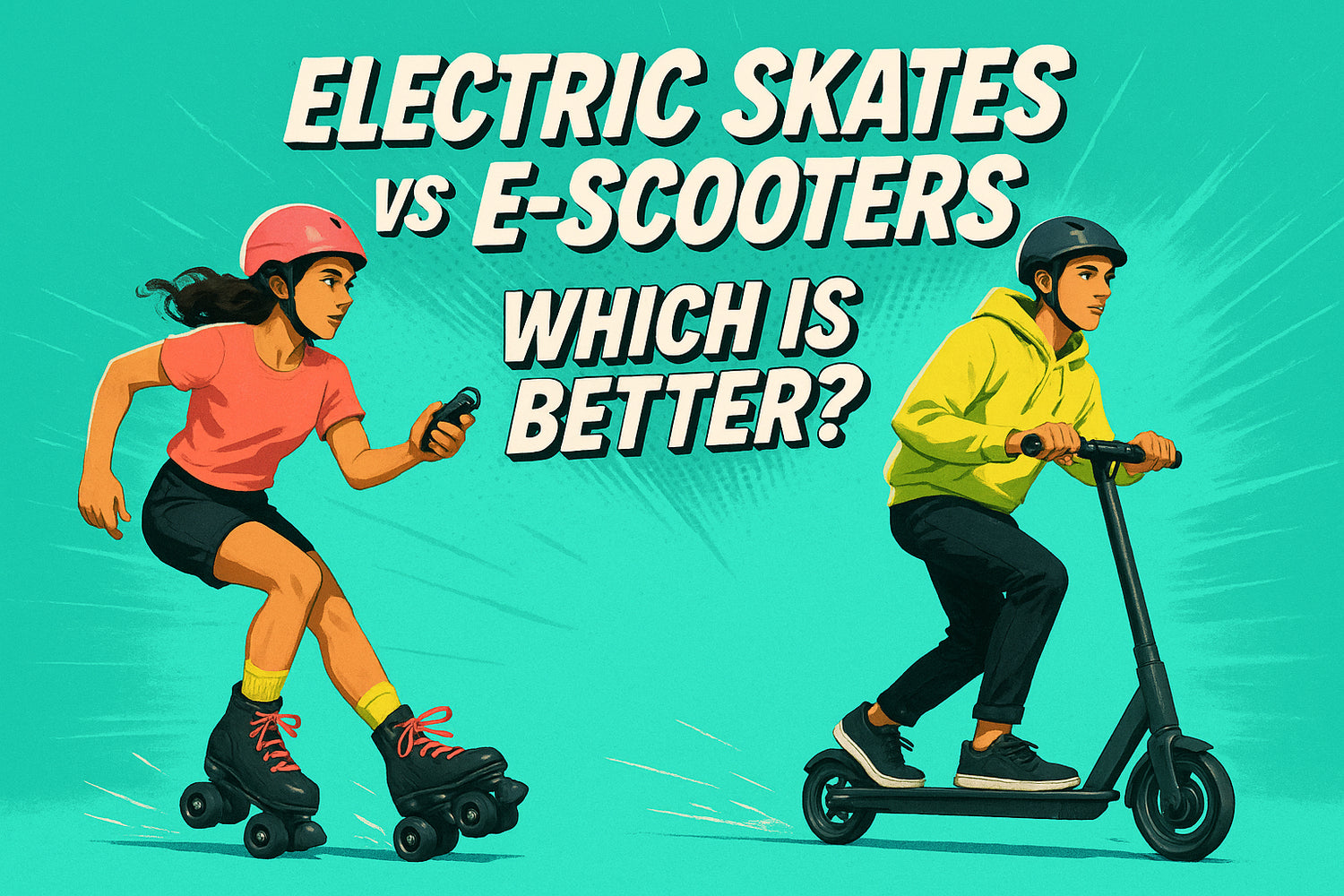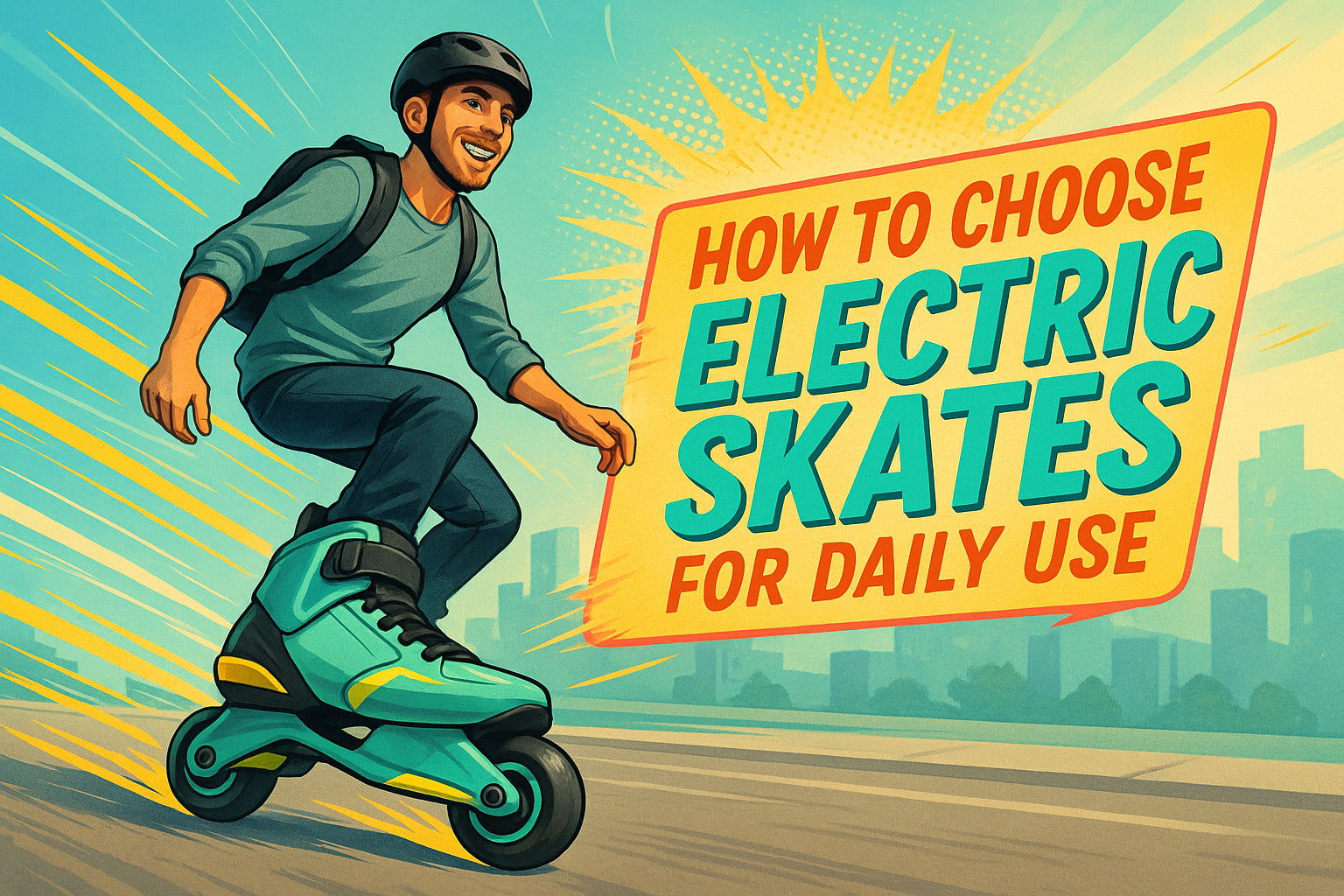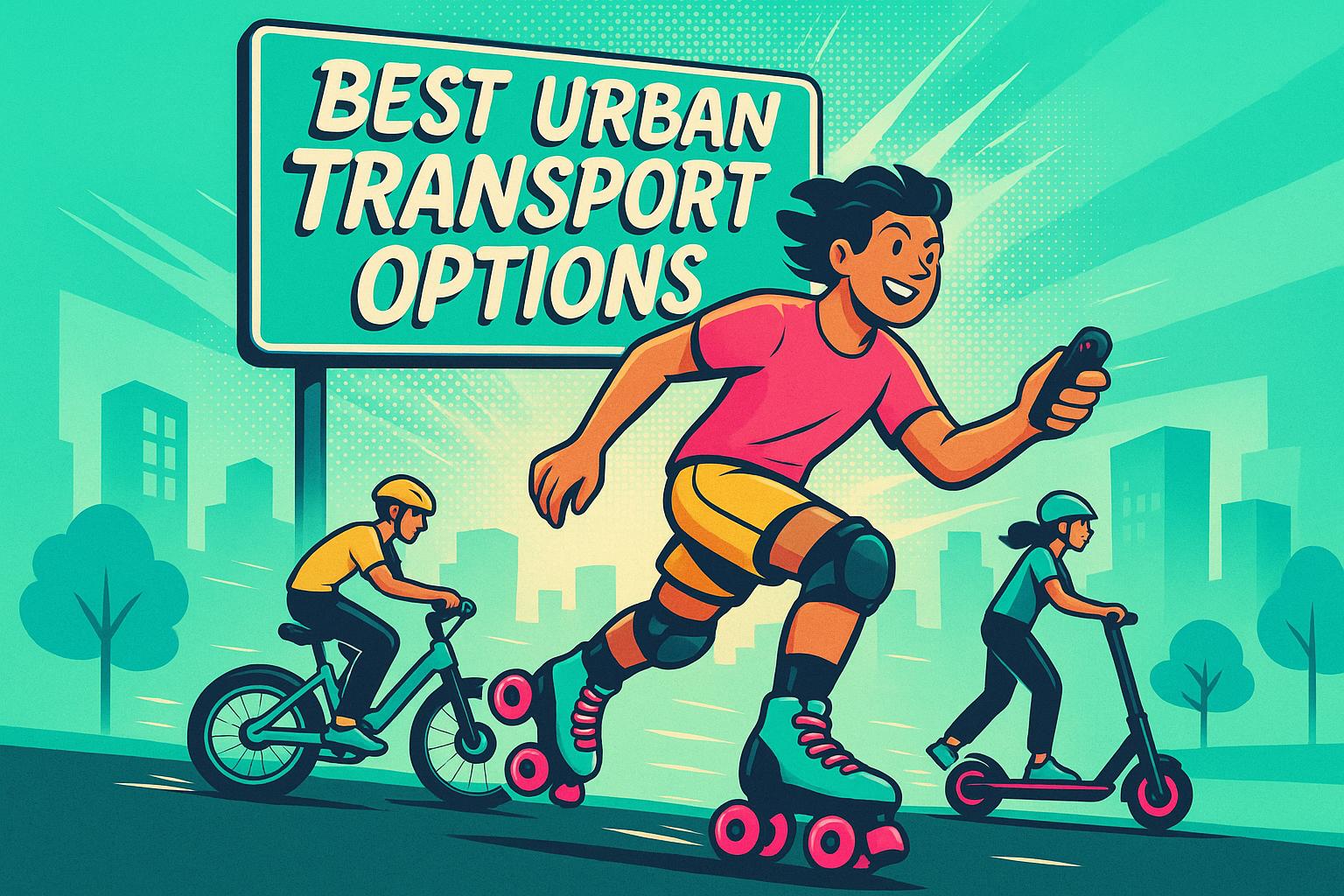When it comes to urban commuting, electric skates and e-scooters both offer eco-friendly, battery-powered travel options. But which one suits your needs better? Here's a quick breakdown:
- Portability: Electric skates are lighter and fit in a backpack, while e-scooters are bulkier but foldable.
- Cost: Electric skates start at $599, while e-scooters range from $300 to $1,500, depending on the model.
- Ease of Use: E-scooters are beginner-friendly with handlebars for stability. Electric skates require balance and practice.
- Range: E-scooters cover 10–30 miles per charge, compared to 5–10 miles for electric skates.
- Safety: E-scooters offer better stability, while electric skates demand more skill to navigate obstacles.
Quick Comparison
| Feature | Electric Skates | E-Scooters |
|---|---|---|
| Portability | Lightweight, fits in bags | Foldable but bulkier |
| Cost | $599 | $300–$1,500 |
| Learning Curve | Steeper, needs practice | Easier, beginner-friendly |
| Range | 5–10 miles | 10–30 miles |
| Safety | Balance-dependent | Stable with handlebars |
If you value portability and shorter commutes, electric skates are a fun and compact option. For longer trips and more stability, an e-scooter is the better choice.
Electric Scooter vs Electric Skateboard: Which Is Right For You?
Portability and Storage
Navigating urban areas demands transportation options that are easy to carry, compact, and simple to store. When it comes to portability, electric skates and e-scooters differ significantly, especially when you need to climb stairs or squeeze into tight spaces. Let’s break down their size, weight, and storage needs.
Size and Weight Comparison
Electric skates, like those from Wheelfeet, shine when it comes to portability. Their lightweight design makes it easy to transition between public transport, indoor spaces, or even a quick carry up a flight of stairs.
E-scooters, on the other hand, cover a wide range in terms of weight. For example, the Segway Air T15 weighs just 23.2 lbs, while the Unagi Model One Classic comes in at 28.5 lbs. At the heavier end, you’ll find models like the Dualtron X Limited, tipping the scales at a hefty 182.8 lbs. While some lighter models are manageable for short distances, heavier e-scooters can be cumbersome for extended carrying.
Storage Requirements
Storage is another key factor to consider. Electric skates easily fit into backpacks, under desks, or in lockers. Their compact design makes them perfect for crowded public transit or even air travel. Plus, they offer added convenience and security since they’re less likely to be left unattended or exposed.
E-scooters, by comparison, require more space. Even foldable models take up room in car trunks, apartments, or offices. In public spaces, their size can sometimes lead to restrictions. Additionally, e-scooters are often parked outside, leaving them more vulnerable to theft or damage.
Cost Analysis
When weighing the costs of electric skates against e-scooters, it’s important to look beyond just the initial price tag. Both upfront costs and ongoing expenses play a role in determining their overall value.
Purchase Price
The Wheelfeet Electric Roller Skates are priced at $599.00, which places them in the budget to mid-range category. By comparison, e-scooters come in a wide range of prices: entry-level models are typically priced between $100 and $600, mid-range options range from $601 to $1,200, and premium models can cost over $1,200. On average, adult e-scooters tend to fall between $300 and $1,500.
This pricing reflects the specialized design and portability of electric skates, which cater to a specific niche.
Operating Expenses
The cost to charge both electric skates and e-scooters is minimal. For example, e-scooters like the Xiaomi Mi M365 cost approximately $0.042 per full charge and $0.0022 per mile. Electric skates have similar charging costs, as they use batteries of comparable size.
Maintenance costs, however, can differ significantly. E-scooters often require more frequent servicing due to their exposed components and larger moving parts. Common maintenance expenses include:
- Brake pad replacements: $75+
- Tune-ups: $60+
- Solid tire swaps: $120+
Additionally, e-scooter batteries typically last 2–3 years before needing replacement. Factoring in these costs, the average ownership cost of an e-scooter is estimated at around 9 cents per mile.
Electric skates, on the other hand, benefit from a simpler design, which generally translates to lower maintenance needs. However, repairs may require specialized services, which could be harder to find.
Long-Term Value
The long-term value of either option depends heavily on how you plan to use them. E-scooters are versatile, offering better speed and terrain adaptability. Electric skates, however, shine in urban settings where their portability and compact design reduce the hassle of parking and minimize the risk of theft. These advantages can result in additional savings, like avoiding parking fees.
Next, we’ll dive into user experience and safety to round out your cost–benefit analysis.
sbb-itb-bf837b9
User Experience and Safety
When deciding between electric skates and e-scooters for your daily commute, it's worth weighing their differences in ease of use, stability, and safety features.
Learning Difficulty
Electric scooters are often the go-to choice for beginners. With handlebars and a wide standing platform, they provide immediate stability and control, making them easier to pick up and ride comfortably. On the other hand, electric skates demand more balance and coordination, much like traditional roller skating, resulting in a steeper learning curve. The Wheelfeet Electric Roller Skates aim to ease this challenge by offering adjustable speed settings, letting new riders start slow and gradually gain confidence before reaching their top speed of 15 mph. However, mastering electric skates still requires more practice compared to scooters.
Beyond the learning process, safety features play a crucial role in setting these two devices apart.
Safety Features
Electric scooters shine when it comes to stability. The combination of handlebars and a sturdy platform makes it easier to stop quickly and stay steady in stop-and-go traffic. In contrast, electric skates rely heavily on the rider's balance, which can make stopping and maneuvering around obstacles more demanding. Wheelfeet skates address this with regenerative braking, a strong frame, and durable wheels for smooth stops. Plus, their wireless remote control allows for precise speed adjustments without disrupting balance.
To summarize the key differences, here's a quick comparison of safety and usability features:
Safety and Usability Comparison
| Factor | Electric Skates (Wheelfeet) | E‑Scooters |
|---|---|---|
| Learning Curve | Longer; requires more practice | Shorter; beginner-friendly |
| Stability | Relies on active balance | Handlebars and platform ensure stability |
| Emergency Stops | Smooth stops with regenerative braking and rider skill | Quick stopping with hand brakes |
| Traffic Navigation | Challenging in stop-and-go situations | Easier to stop and stay stationary |
| Maneuverability | Excellent turning via natural leaning | Good turning with handlebars |
| Fall Risk | Higher due to balance demands | Lower thanks to built-in support |
| Control | Wireless remote and body positioning | Handlebars with throttle control |
Electric skates excel in maneuverability, especially on smooth surfaces. Their natural skating motion allows for fluid direction changes, making them ideal for navigating tight urban spaces. However, their reliance on balance and skill means they may not be as forgiving in high-traffic or unpredictable conditions compared to e-scooters.
Performance and Environmental Impact
Beyond cost and safety, performance and environmental factors play a critical role in differentiating these devices. Let’s take a closer look at how they perform daily and their impact on the environment.
Speed and Range
E-scooters typically reach speeds of about 15 mph and offer a range of 10–30 miles per charge. On the other hand, electric skates can hit speeds of up to 28 mph but offer a shorter range of 5–10 miles. For example, the Wheelfeet Electric Roller Skates provide a top speed of 15 mph with a range of up to 9 miles per charge.
The difference in range comes down to battery size and energy efficiency. E-scooters can house larger batteries, thanks to their design, enabling longer rides without needing a recharge. Electric skates, with their compact build, prioritize portability and use smaller batteries. E-scooters also deliver quicker acceleration and steady power, while electric skates require gradual acceleration to maintain balance and control.
Terrain Handling
Urban settings often present varied surfaces, and each device handles these differently. E-scooters shine on smooth pavements, bike lanes, and well-maintained sidewalks. Their larger wheels and stable platform, combined with handlebars, make them more adept at navigating around potholes, curbs, and other obstacles.
Electric skates, including models like Wheelfeet, perform best on flat, smooth surfaces such as indoor floors, bike paths, or freshly paved roads. However, their smaller wheels and lower ground clearance make them more vulnerable to surface imperfections like cracks, gravel, or wet patches. These conditions demand more skill and focus from the rider. That said, their compact design allows for excellent maneuverability in tight or crowded areas.
Environmental Impact
Both devices offer eco-friendly transportation options, but their environmental footprints differ. E-scooters are highly energy-efficient, consuming about 0.018 mWh per kilometer - significantly less than the 0.15 kWh per kilometer used by electric cars. Over their lifespan, e-scooters emit an average of 35–67 grams of CO2 per mile, which is roughly one-ninth of a typical car’s emissions.
Electric skates, with their smaller batteries and motors, generally use less electricity per ride. However, their shorter range often leads to more frequent charging, which can offset some of the energy savings. Features like regenerative braking, which recaptures energy during stops, help improve their efficiency.
Both devices rely on lithium-ion batteries, which require specialized recycling. Manufacturing these batteries involves energy-intensive mining and refining processes. E-scooters, due to their larger size and additional components like handlebars and displays, require more raw materials compared to the simpler design of electric skates. Studies show that extending the lifespan of shared e-scooters can reduce their environmental impact by 26–47%, while increasing daily usage can lower it by as much as 50–80%. Similarly, personal electric skates benefit from regular maintenance and extended use, maximizing their eco-friendly potential.
Ultimately, the environmental benefits of both devices depend on proper care, responsible battery recycling, and manufacturers adopting sustainable practices like using recycled materials and renewable energy in production.
Up next, we’ll see how these performance and environmental factors can guide your final decision.
Making Your Choice
After breaking down portability, cost, safety, and performance, here’s a handy guide to help you pick the right option for your needs.
Distance is key. If your commute is under 5 miles and mostly on smooth surfaces, electric skates like Wheelfeet are a lightweight, portable choice. But for trips between 10 and 30 miles in busy urban areas, e-scooters deliver better range and stability. As Levi Conlow, CEO and co-founder of Lectric eBikes, puts it:
"With portability comes convenience. If riders feel inconvenienced, they're not going to ride it."
Think about your commuting environment. E-scooters excel in crowded cities where traffic and uneven surfaces are part of the daily grind. On the other hand, electric skates shine on smooth pavements or indoors, offering great agility in tight spaces - though they demand more skill on rough terrain.
Budget matters. E-scooters typically cost between $300 and $1,500, while electric skates start at around $599.
Safety should always come first. E-scooters provide more inherent stability, while electric skates require balance but can be rewarding for skilled riders. Keep in mind that 83% of e-bike and e-scooter accidents happen in urban areas, and only 43% of riders wear helmets. No matter your choice, always wear protective gear and practice in a secure location.
Don’t forget about storage. If you live in an apartment, take public transit, or need to carry your device upstairs, electric skates are easier to manage thanks to their compact size. E-scooters can fold, but their bulkier design can be a challenge in tight spaces.
Ultimately, if portability, short commutes, and a bit of fun are your priorities, electric skates are a great fit. But if you need a reliable, long-range option that handles diverse urban conditions, an e-scooter might be the better choice for your lifestyle.
FAQs
Which option is more eco-friendly: electric skates or e-scooters?
Electric skates generally leave behind a smaller carbon footprint compared to e-scooters. Manufacturing electric skates produces about 100 to 200 kg of CO2e, though the exact figure varies based on production methods and usage habits.
On the other hand, e-scooters, despite helping to cut down on car emissions, often come with higher environmental costs. This is due to the materials used, energy-intensive manufacturing, frequent charging requirements, and their relatively short lifespans paired with lower usage rates. These factors can significantly add to their overall impact.
For those prioritizing sustainability, electric skates tend to be the more eco-friendly option. However, the environmental effects of either choice ultimately hinge on how they’re made and cared for.
How do I decide between electric skates and e-scooters for commuting in the city?
Choosing between electric skates and e-scooters boils down to your specific lifestyle and travel needs. Let’s break it down:
If portability matters, electric skates are a clear winner. They’re lightweight and easy to carry, making them convenient for short commutes or mixed travel (like hopping on public transit). On the other hand, e-scooters, while bulkier, often come with foldable designs that make storage and transport manageable.
When it comes to range and practicality, e-scooters usually take the lead. They’re built to cover longer distances on a single charge, making them a better option for extended trips or daily commutes.
Ease of use and safety are worth considering too. E-scooters are more stable and beginner-friendly, which makes them a great choice for those new to electric transportation. Electric skates, however, require more balance and skill but reward you with unmatched agility and maneuverability.
Both options are eco-friendly, so your decision might come down to factors like distance, budget, and comfort level. Think about how you plan to use it day-to-day and choose the one that complements your routine best.
What safety tips should I follow when using electric skates or e-scooters?
When riding electric skates, safety should always come first. These devices demand more balance and control compared to e-scooters, so it's important to gear up properly. Make sure to wear a helmet, knee pads, and elbow pads to protect yourself from potential falls. Start by practicing in a quiet, controlled area before heading into busier spaces, and keep your speed at a level where you feel stable and in control.
For e-scooters, safety measures are just as important. Always wear a helmet, follow traffic rules, and avoid riding on sidewalks where it's not allowed. While the handlebars offer added stability, it's still essential to stay focused, minimize distractions, and watch out for uneven terrain or obstacles. Whether you're on electric skates or an e-scooter, staying aware of your surroundings and adopting responsible riding habits will help ensure a safer and more enjoyable ride.




Leave a comment
All comments are moderated before being published.
This site is protected by hCaptcha and the hCaptcha Privacy Policy and Terms of Service apply.